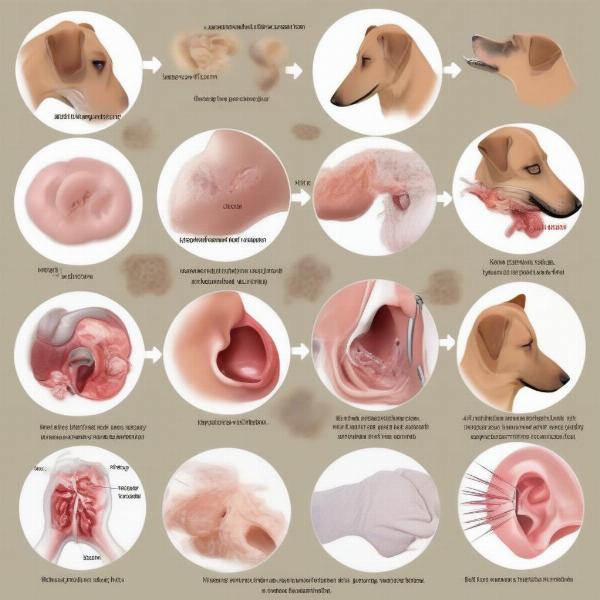A bleeding dog ear can be alarming, but it’s important to stay calm and assess the situation. Understanding how to treat a bleeding dog ear effectively can help alleviate your dog’s discomfort and prevent further complications. This article provides a step-by-step guide to managing a bleeding dog ear, covering everything from initial first aid to when veterinary care is necessary.
Identifying the Cause of Bleeding
Before treating a bleeding dog ear, try to identify the cause of the bleeding. Common causes include:
- Ear infections: Inflammation and scratching can lead to bleeding.
- Ear mites: These tiny parasites cause intense itching and irritation, often resulting in bleeding from excessive scratching.
- Foreign objects: Grass seeds, twigs, or other objects lodged in the ear canal can cause trauma and bleeding.
- Trauma: A cut or injury to the ear flap or canal can result in bleeding.
- Blood clotting disorders: While less common, underlying health issues can contribute to bleeding.
 Dog ear bleeding causes
Dog ear bleeding causes
Immediate First Aid for a Bleeding Dog Ear
If your dog’s ear is bleeding, follow these steps:
- Stay Calm: Your dog will sense your anxiety, so remaining calm is crucial.
- Restrain Your Dog Gently: Secure your dog to prevent further injury during the examination and treatment.
- Assess the Bleeding: Determine the source and severity of the bleeding. If the bleeding is profuse or you suspect a deep wound, seek immediate veterinary attention.
- Apply Pressure: If the bleeding is mild, apply gentle pressure to the affected area using a clean cloth or gauze. Hold the pressure for several minutes until the bleeding slows or stops.
- Clean the Area (if possible): If the wound is superficial and the bleeding has stopped, gently clean the area around the ear with a sterile saline solution. Avoid inserting anything into the ear canal.
When to Seek Veterinary Care
While minor bleeding may resolve with first aid, it’s important to seek veterinary care in the following situations:
- Heavy or continuous bleeding: This indicates a more serious injury.
- Deep wounds or lacerations: These require professional cleaning and possibly stitches.
- Suspected foreign object: Attempting to remove a foreign object yourself can cause further damage.
- Signs of infection: Swelling, redness, pus, or a foul odor indicate infection.
- The dog is in pain or distress: Whimpering, shaking, or pawing at the ear indicates discomfort.
Long-Term Care and Prevention
After the initial bleeding has been addressed, follow your veterinarian’s instructions for ongoing care. This may include:
- Medication: Antibiotics or anti-inflammatory medications may be prescribed to treat infection or reduce swelling.
- Ear cleaning: Your veterinarian may recommend a specific ear cleaning solution and technique.
- E-collar: An Elizabethan collar (e-collar) can prevent your dog from scratching or further injuring the ear.
To prevent future ear bleeding:
- Regular ear checks: Inspect your dog’s ears weekly for signs of redness, swelling, discharge, or foreign objects.
- Regular ear cleaning: Clean your dog’s ears as recommended by your veterinarian.
- Parasite prevention: Use preventative medications to protect your dog from ear mites and other parasites.
- Grooming: Keep the hair around the ears trimmed to improve air circulation and reduce the risk of infection.
Conclusion
A bleeding dog ear can be a concerning experience, but knowing how to respond promptly and effectively can significantly impact your dog’s recovery. By following the guidelines outlined in this article and seeking veterinary care when necessary, you can help ensure your furry friend’s well-being. Remember, prompt attention and proper care are essential for a healthy and happy dog.
FAQ
- Q: Can I use hydrogen peroxide to clean my dog’s bleeding ear?
A: No, hydrogen peroxide can irritate the delicate tissues of the ear canal and delay healing. - Q: What should I do if I can’t stop the bleeding?
A: Apply direct pressure and seek immediate veterinary attention. - Q: How can I prevent my dog from scratching its ears?
A: Use an Elizabethan collar (e-collar) to prevent scratching. - Q: How often should I clean my dog’s ears?
A: Consult your veterinarian for recommendations based on your dog’s breed and individual needs. - Q: Are certain dog breeds more prone to ear problems?
A: Yes, breeds with long, floppy ears are more susceptible to ear infections and other ear problems. - Q: Can ear bleeding be a sign of a serious underlying health issue?
A: While rare, ear bleeding can be a symptom of a blood clotting disorder. Consult your veterinarian for a proper diagnosis. - Q: How much does it typically cost to treat a bleeding dog ear at the vet?
A: The cost varies depending on the cause and severity of the bleeding, but it’s important to prioritize your dog’s health and seek professional care when needed.
ILM Dog is a leading online resource for dog owners worldwide, providing expert advice on all aspects of dog care and wellbeing. We cover a wide range of topics, from breed selection and health care to training, nutrition, and grooming. Our team of experienced writers and dog experts is dedicated to providing practical, reliable information to help you give your canine companion the best possible care. If you have any questions or would like to learn more about our services, please contact us at [email protected] or call us at +44 20-3965-8624. ILM Dog – Your trusted partner in dog care.